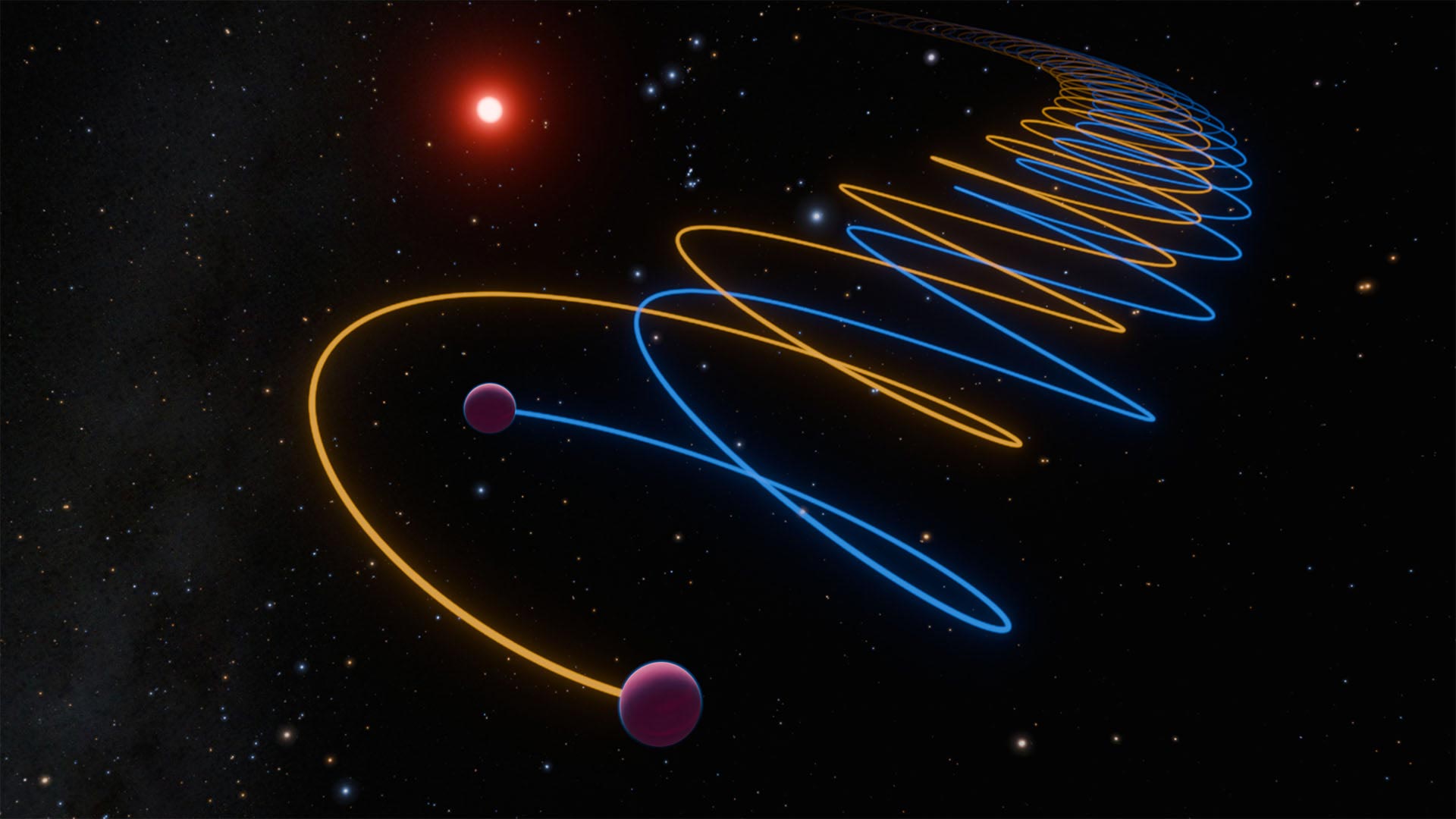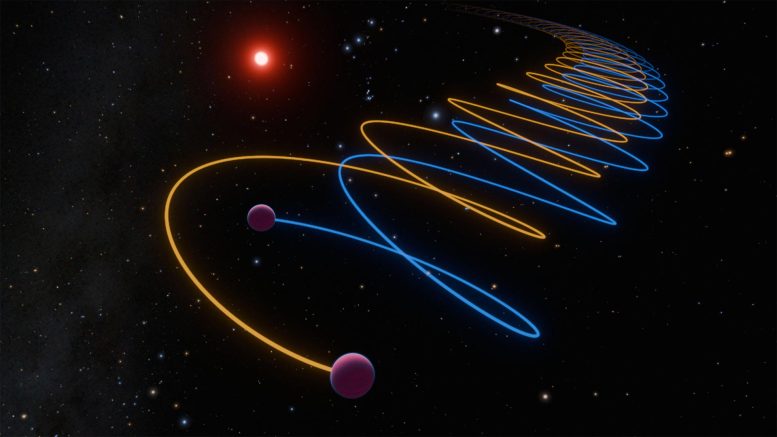

Astronomers resolve longstanding mystery of Gliese 229B’s dimness, despite its considerable mass.
A Caltech-led team discovered that the brown dwarf is actually a close binary system, consisting of two brown dwarfs orbiting each other. This discovery provides fresh insights into brown dwarf binaries and poses new questions about their formation and prevalence in the cosmos.
Discovery of Gliese 229B: A Brown Dwarf Mystery
Since its discovery in 1995 by Caltech researchers at the Institute’s Palomar Observatory hundreds of papers have been written about Gliese 229B, the first known brown dwarf. But a pressing mystery has persisted about this orb: it is unusually dim light, given its substantial mass. Typically, brown dwarfs—celestial objects heavier than gas giants like Jupiter but lighter than stars—of this mass should emit much more light. Measurements indicated that Gliese 229B was about 70 times the mass of Jupiter, yet its luminosity did not match this heft.
Recently, this enigma was unraveled by a Caltech-led team of international astronomers. They discovered that what was presumed to be a single brown dwarf is actually two closely orbiting brown dwarfs, with a mass of approximately 38 and 34 times that of Jupiter, circling each other every 12 days. The brightness observed corresponds to the expected luminosity for two such smaller, dimmer brown dwarfs, solving the long-standing puzzle of Gliese 229B’s dimness.
Discovery and Implications
“Gliese 229B was considered the poster-child brown dwarf,” says Jerry W. Xuan, a graduate student working with Dimitri Mawet, the David Morrisroe Professor of Astronomy. “And now we know we were wrong all along about the nature of the object. It’s not one but two. We just weren’t able to probe separations this close until now.” Xuan is lead author of a new study, published today (October 16), reporting the findings in the journal Nature. A separate independent study in The Astrophysical Journal Letters, led by Sam Whitebook, a Caltech graduate student, and Tim Brandt, an associate astronomer at the Space Telescope Science Institute in Baltimore, also concluded that Gliese 229B is a pair of brown dwarfs.
The discovery leads to new questions about how tight-knit brown dwarf duos like this one form and suggests that similar brown dwarf binaries—or even exoplanet binaries—may be waiting to be found. (An exoplanet is a planet that orbits a star other than our Sun.)
“This discovery that Gliese 229B is binary not only resolves the recent tension observed between its mass and luminosity but also significantly deepens our understanding of brown dwarfs, which straddle the line between stars and giant planets,” says Mawet, who is also a senior research scientist at JPL, which is managed by Caltech for NASA.
Historical Significance of Gliese 229B
Gliese 229B was discovered in 1995 by a Caltech team that included Rebecca Oppenheimer, then a Caltech graduate student; Shri Kulkarni, the George Ellery Hale Professor of Astronomy and Planetary Science; Keith Matthews, an instrument specialist at Caltech; and other colleagues. The astronomers used Palomar Observatory to discover that Gliese 229B possessed methane in its atmosphere—a phenomenon typical of gas giants like Jupiter but not of stars. The finding marked the first confirmed detection of a class of cool star-like objects called brown dwarfs—the missing link between planets and stars—that had been theorized about 30 years prior.
“Seeing the first object smaller than a star orbiting another sun was exhilarating,” says Oppenheimer, who is a co-author of the new study and an astrophysicist at the American Museum of Natural History. “It started a cottage industry of people seeking oddballs like it back then, but it remained an enigma for decades.”
The Puzzling Dimness of Gliese 229B
Indeed, nearly 30 years after its discovery and hundreds of observations later, Gliese 229B still puzzled astronomers with its unexpected dimness. The scientists suspected Gliese 229B might be twins, but “to evade notice by astronomers for 30 years, the two brown dwarfs would have to be very close to each other,” says Xuan.
To resolve Gliese 229B into two objects, the team used two different instruments, both based at the European Southern Observatory’s Very Large Telescope in Chile. They used the GRAVITY instrument, an interferometer that combines light from four different telescopes, to spatially resolve the body into two, and they used the CRIRES+ (CRyogenic high-resolution InfraRed Echelle Spectrograph) instrument to detect distinct spectral signatures from the two objects. The latter method involved measuring the motion (or doppler shift) of molecules in the atmosphere of the brown dwarfs, which indicated that one body was headed toward us on Earth and the other away—and vice versa as the pair orbited each other.
“It is so nice to see that almost 30 years later, there has been a new development,” says Kulkarni, who is not an author on the current paper. “Now this binary system stuns again.”
A Whirling Cosmic Dance: Orbital Characteristics
These observations, taken over five months, showed that the brown dwarf duo, now called Gliese 229Ba and Gliese 229Bb, orbit each other every 12 days with a separation only 16 times larger than the distance between Earth and the Moon. Together, the pair orbit an M-dwarf star (a smaller, redder star than our Sun) every 250 years.
“These two worlds whipping around each other are actually smaller in radius than Jupiter. They’d look quite strange in our night sky if we had something like them in our own solar system,” says Oppenheimer. “This is the most exciting and fascinating discovery in substellar astrophysics in decades.”
The Mystery of Their Formation
How this whirling pair of cosmic orbs came to be is still a mystery. Some theories say brown dwarf pairs could form within the swirling disks of material that encircle a forming star. The disk would fragment into two seeds of brown dwarfs, which would then become gravitationally bound after a close encounter. Whether these same formation mechanisms are at work to form pairs of planets around other stars remains to be seen.
Future Exploration of Brown Dwarf Binaries
In the future, the team would like to search for even more closely orbiting brown dwarf binaries with instruments such as the Keck Planet Imager and Characterizer (KPIC), which was developed by a team led by Mawet at the W. M. Keck Observatory in Hawai’i, as well as the Keck Observatory’s upcoming High-resolution Infrared SPectrograph for Exoplanet Characterization (HISPEC), which is under construction at Caltech and other laboratories by a team led by Mawet.
“The fact that the first known brown dwarf companion is a binary bodes well for ongoing efforts to find more,” says Xuan.
Reference: “The cool brown dwarf Gliese 229B is a close binary” 16 October 2024, Nature.
DOI: 10.1038/s41586-024-08064-x
The work was funded by NASA and the Heising-Simons Foundation. Other Caltech authors include Yapeng Zhang, a 51 Pegasi b Postdoctoral Scholar Research Associate in Astronomy; Aniket Sanghi, a graduate student; Konstantin Batygin, professor of planetary science; and Heather Knutson, professor of planetary science.